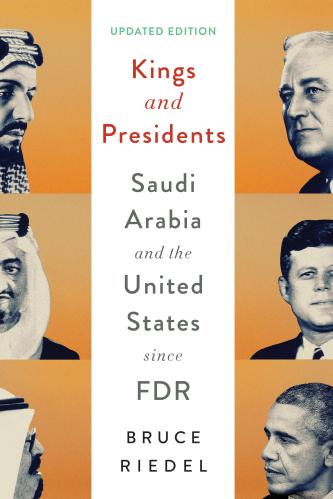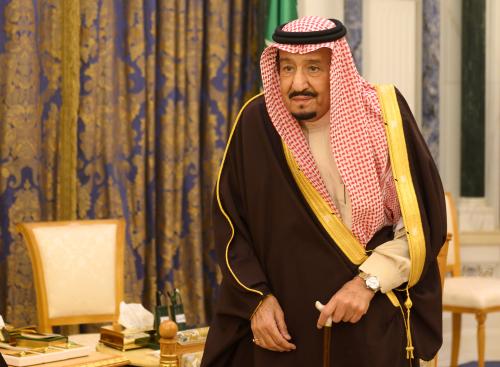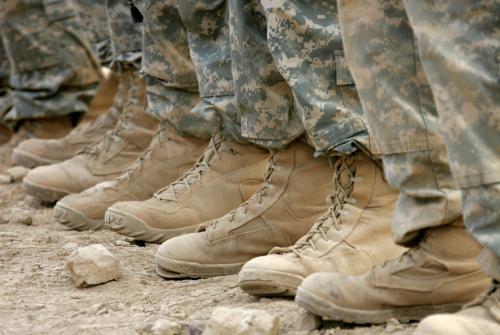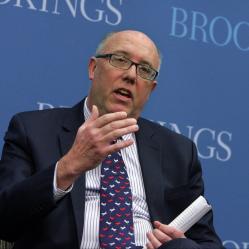Sixty years ago, the House of Saud for the first and only time stripped a sitting king of his powers and turned them over to another prince. The episode was a crucial and defining moment in Saudi history, and it is worth studying as we ponder the future of the Kingdom of Saudi Arabia.
Sixty years ago, the House of Saud for the first and only time stripped a sitting king of his powers and turned them over to another prince. The immediate cause of King Saud’s fall from power was a botched Saudi intelligence plot to assassinate Egypt’s President Gamal Abdel Nasser and put in Syria a military junta favoring Riyadh. Once Nasser publicly exposed Saud’s plot, the family backed by the Wahhabi clergy moved quickly to transfer power to Crown Prince Faisal. It was seen in Washington at the time as a major setback for America.
There are obvious comparisons to today. Saud was widely regarded as unfit to rule before Nasser exposed him because of his incompetence and corruption, much as Crown Prince Mohammed bin Salman (MBS) is today regarded by his many critics. Saud was behind a botched intelligence caper; MBS was the mastermind behind the premeditated murder of journalist Jamal Khashoggi, according to Senators briefed on the CIA’s assessment of the Istanbul caper.
The 1958 episode was a crucial and defining moment in Saudi history. Faisal is rightfully regarded as the savior of the kingdom. The situations then and now have many differences, but it is worth studying what happened in 1958 as we ponder the future of the Kingdom of Saudi Arabia. The article below was originally published in the December issue of Studies in Intelligence.
Policymakers often turn to their security and intelligence services when they want a fairly quick and cheap solution to a complex and difficult political challenge abroad. In my experience in 30 years in the government, including working directly for four presidents in the White House, I have witnessed the allure of covert action for chief executives. And so it was before my time. In 1953 President Dwight David Eisenhower turned to the Central Intelligence Agency (CIA) to rid himself of a nationalist government in Iran. Kermit Roosevelt, the agency’s master spy, produced Operation Ajax, which ousted the nationalists in a military coup and restored the shah to power. The coup gave Director of Central Intelligence (DCI) Allen Dulles new standing in Eisenhower’s eyes and made Kermit Roosevelt famous. (Decades later he would write a book about the affair.)
Five years later America’s oldest ally in the Arab world, Saudi Arabia, tried to emulate Roosevelt and rid itself of the danger posed by Arab nationalists and revolutionaries by sponsoring a coup in Syria. The coup plot was the pet project of King Saud, who had ascended to the throne in 1953 when his father Abd Al Aziz al Saud, the founder of the modern kingdom, died. Saud was also Eisenhower’s personal choice to be the US antithesis to Egypt’s President Gamal Abd al Nasser. The king would rally the Arabs to America’s side in the Cold War. Washington knew the Saudis were working on a coup in Damascus; the Saudis told them.
Unfortunately for Saud the coup was a half-baked scheme, maybe worse, a provocation and setup. The Egyptians and Syrians, then united in the United Arab Republic (UAR), were aware of the conspiracy and announced it to the world on 5 March 1958. Saud would be the major victim of the coup he plotted. On 24 March, the Saudi royal family convened in Riyadh and transferred most of Saud’s powers to his brother Crown Prince Faysal. Ike’s answer to Nasser was still king but without the power to rule.
Saud and Ike
On 1 February 1958, the UAR was created by the merger of Syria and Egypt. It was not Gamal Abd al Nasser’s idea. In fact, initially in January, when the Syrians first approached him, Nasser resisted the proposal to unite the two countries because they were separated by Israel. He realized that the physical separation was a major barrier to real unity. But the weak government in Damascus—a coalition of several groups, including Ba’athists—was determined that their survival was only possible if they aligned with Nasser and if Syria, in effect, went out of existence. The Ba’athists were especially worried by the strength of the Syrian Communist Party, which they feared would launch a coup and take power. It is an irony that the UAR was created in part by fear of communism, since Washington would come to portray the UAR as a veritable arm of international communism.
Nasser drove a hard bargain. He insisted that merger must come along with the dissolution of all political parties in Syria, including both the Ba’athists and the communists as well as any other, and the Syrian officer corps must quit playing politics. He would become president with a new parliament and a new constitution. The Egyptian flag, the Arab nationalist banner with horizontal bars of red, white and black would be the UAR flag but with two stars; one for Egypt and one for Syria. The Syrian politicians who had come to Cairo to ask for unity had no choice but to accept Nasser’s terms. He would move to oust many of them from power, arrest the communist leadership, and put Egyptians in charge of most Syrian decisionmaking.
The news of the merger on 1 February was met with massive crowds of Egyptians and Syrians chanting Nasser’s name. Crowds poured through Cairo and Alexandria at the news that an Egyptian was leading the Arab world. Huge crowds hailed the news in Damascus, Aleppo, and other Syrian cities. Tens of thousands of Lebanese flocked to Damascus to cheer too.
Elsewhere in the region there was fear and trepidation. The monarchs of the Arab world were the most fearful. One of their number, Egypt’s King Farouk, had already fallen to Nasser. Who was next? How to stop the tide of revolution from sweeping every king away? Were the Arab world’s monarchs going to tumble away like a line of dominoes?
The Hashemite monarchs in Baghdad and Amman were the first to react. On 14 February 1958, King Faysal II in Iraq and King Hussein in Jordan announced their own union, the Arab Federation, which would bring their two countries together in a confederation under Faysal. Baghdad would be the capital. King Hussein would continue to rule in Jordan but in a secondary position to his cousin in Iraq. The bureaucracies and armies of the two states were eventually to be merged but the time frame for that was kept open. The Arab world was split in two, Nasser’s UAR facing the Hashemite’s federation.
The house of Saud was just as worried as its old nemesis the house of Hashim. King Saud had good reason to be worried. He and his country were broke because he spent the kingdom’s oil wealth on his own entertainment and corruption. He was a notorious gambler. Much of the royal family had become disillusioned about Saud and that disillusionment had turned to active campaigning to limit his powers or even depose him. There was no precedent for doing so, however, in the history of the Saudi kingdoms going back to 1744. When the royal family became divided, as happened often in the late 1800s, it fell into civil war. No one in the family wanted that but pressure to clip Saud’s power was building.
For President Dwight David Eisenhower and Secretary of State John Foster Dulles … They hoped the king, a charismatic pro-West figure, could galvanize Arab nationalism and become the answer to Nasser.
For President Dwight David Eisenhower and Secretary of State John Foster Dulles, however, Saud was their man. They hoped the king, a charismatic pro-West figure, could galvanize Arab nationalism and become the answer to Nasser. Saudi Arabia was America’s oldest ally in the Arab world, American oil companies were dominant in the kingdom, and the US Air Force had a base in Dhahran that had its origins in WWII. “The king could be built up, possibly as a spiritual leader first,” Ike, referring to the king’s status as the defender of the two holy mosques in Mecca and Medina, told his aides.
Complicating the situation, the Saudis were cool to the United Kingdom. There were outstanding border disputes between the Saudis and the British protectorates that hugged the coast of the Persian Gulf. This was particularly so over the Buraimi Oasis that both Saudi Arabia and what was then called the Trucial States (today the United Arab Emirates) claimed. The Saudis were also the longstanding opponents of the Hashemites, whom the British had put in power in Jordan and Iraq. Washington felt that the Saudis were a more comfortable ally than the Hashemites and that Saud was a more likely leader of Arab nationalists friendly to America than the Hashemites, who were widely seen as British puppets. Moreover, the Saudis had broken relations with the UK during the 1956 Suez crisis and cut off oil.
King Saud visited Washington in late January and early February 1957. He was the first Saudi king to visit the United States. Eisenhower met the king on his arrival at National Airport, an unprecedented sign of the importance of the visit and the visitor. The royal party exceeded 80 people, including some of Saud’s wives and children. They were so numerous that Blair House, the official guest house of the White House, could not manage the entire party and some of Saud’s bodyguards pitched tents on Lafayette Square. What had been planned as a three-day visit stretched to nine days. The king met with Ike and Vice President Richard Nixon as well as many cabinet members and members of Congress. There were numerous official dinners and lunches.
King Saud held a dinner in honor of Eisenhower. As one American diplomat present observed “the scene was lavish in the extreme, with a huge guest list and an ice sculpture as the centerpiece of the extended banquet hall.” The whole performance was to build up Saud as the counterweight to Nasser, “an idea that proved to be a miscalculation.”
The official communique at the end of the visit noted that “Saudi Arabia, by virtue of its spiritual, geographical and economic position, is of vital importance” to the Middle East and world peace. While Saud did not directly endorse the Eisenhower Doctrine—Eisenhower had publicly proclaimed America’s commitment to defend the Middle East against international communism in January 1957—he expressed support for its objectives and appreciation for the president’s “exposition” of its purpose. The two countries agreed to extend the lease for the Dhahran airfield for an additional five years. The United States would also provide training for the Royal Guards and two regular divisions of the Saudi Army, and sell the Saudis tanks and aircraft.
Throughout 1957, Ike regarded Saud as his alternative to Nasser. US diplomacy sought to portray the Saudi king as the true leader of the Arab and Islamic worlds, one who was pro-American and an enthusiastic opponent of international communism. The Saudis had no relations with Russia.
Plot and Fallout
On 3 March 1958 King Saud met with the US ambassador in Saudi Arabia. At the end of the meeting the keeper of the privy purse, Saud’s closest aide, took the ambassador aside and told him that the king wanted Eisenhower to know that “a successful military revolution would take place within a few days in Syria.” The king wanted this information conveyed to the president and Secretary Dulles in the shortest possible time and hoped for a response.
A surprised and worried Eisenhower responded immediately to the king’s message, saying he appreciated the confidence the king was demonstrating in Washington on a crucial issue. It was a positive response. Behind the scenes, the US embassy in Damascus expressed “serious doubts” about the “bona fides” of the Saudi-backed plot. The US ambassador in Syria told Washington that he feared the plot was a provocation to discredit Saud. The CIA also told Eisenhower that Saud’s plot was probably compromised and that Saud “was falling into a trap,” as Eisenhower later wrote in his memoir.
It was too late. On 5 March 1958, Nasser announced in a speech in Damascus that King Saud was behind a plot to assassinate him and break up the UAR by a coup in Syria. Nasser’s head of Syrian intelligence Col. Abdul Hamid al Sarraj confessed that the Saudis had given him 2 million British pounds to put a bomb on board Nasser’s plane to blow up the Egyptian leader. To prove its case, the Egyptian government gave to the press three checks the Saudis allegedly gave to the Syrian plotters. Nasser then labeled Saud an enemy of the Arab people and a puppet of the West. The Egyptian propaganda machine took off after the king. The supposed coup appeared to be a sting operation.
The next day DCI Dulles told the National Security Council (NSC) that “a dramatic development had occurred over the course of last night. Nasser was now fully engaged in an all-out battle with the remaining pro-Western Arab leaders.” More specifically Dulles warned that “King Saud’s position is gravely endangered by these developments.” Dulles told Eisenhower the king’s position was so weakened by the exposure of the Syrian plot that it constituted a trend that could lead to the collapse of the pro-Western regimes in Iraq, Jordan, and elsewhere in the Near East, “and we may find that the USSR will take over control of this whole oil-rich area.” The DCI concluded “the situation is extremely grave.”
In an urgent message to Riyadh, Eisenhower expressed his strong support for King Saud in the face of the “attacks by [the] UAR against His Majesty” broadcast on Nassar’s Voice of the Arabs. The State Department, like the CIA, “had grave apprehensions concerning the possible results for Saud.”
It was an extraordinarily bleak assessment that would have repercussions for the rest of 1958. The estimate formed the basis for a sense of alarm in Washington that would only get worse. In fact, inside Saudi Arabia Dulles’s warning would prove prescient. On 24 March 1958, the royal family convened in Riyadh and stripped Saud of his powers on internal, foreign and financial issues and gave them to his half-brother Crown Prince Faysal. Faysal had persuaded the family not to force Saud to abdicate but to give up control of the kingdom. Saud would remain king but Faysal would rule. Radio Mecca announced Saud was leaving for Switzerland.
Washington was deeply alarmed by Saud’s departure and concerned about Faysal’s commitment to resisting Nasser. On 27 March, DCI Dulles briefed the NSC on the changes in Riyadh. He expressed concern that Faysal “will arrange some kind of tie-up with Syria and Egypt,” in effect joining the Nasser camp. But Dulles also provided a brief character sketch of Faysal that said he was not anti-American and “definitely anti- communist.” Vice President Nixon described Faysal as “pro-American and smart as hell.” Ike recalled that Faysal had been “extremely pleasant in his contacts in Washington.” The CIA was instructed to assess the implications of the change in Saudi Arabia.
The affair and its resulting demotion of Saud were seen as a “victory for Nasserism and a repudiation of Saud’s open anti-Nasser, pro West policy.”
In April, the Intelligence Community provided a special national intelligence estimate (SNIE) entitled Implications of Recent Governmental Changes in Saudi Arabia to the White House. The SNIE reviewed the events of the so-called Sarraj affair, the coup plot in Syria named for the former Syrian intelligence chief who produced the checks implicating King Saud. The affair and its resulting demotion of Saud were seen as a “victory for Nasserism and a repudiation of Saud’s open anti-Nasser, pro West policy.” Faysal was expected to take a more “neutral” posture in inter-Arab affairs and avoid open disputes with the UAR and Nasser. This would find favor in the Saudi “army officer corps,” which had become Egyptianized over years of cooperation with Egypt and with the “Hejazi merchant community.”
Nonetheless, the SNIE also noted that Faysal would be a “traditional Saudi prince” and determined to retain Saudi independence from Nasser. It noted Faysal supported the Dhahran airfield agreement of 2 April 1957, which kept the US Air Force in the kingdom. The chief impact of Saud’s removal would be on Jordan, where Faysal was cutting financial subsidies to King Hussein and withdrawing Saudi troops from the country. The SNIE predicted that Faysal would practice “intense antagonism” toward Israel. A few days after the SNIE was published, DCI Dulles told the NSC that Faysal had told the base commander at Dhahran to cease flying the US flag at the base.17
The Syrian debacle was a turning point in 1958, a symbol of Nasser’s growing prestige and power. The conservative camp in the Middle East was weakened and Ike’s protégé, Saud, removed from the picture. It would be several years before Saud abdicated, by which time Faysal had turned dramatically against Nasser. Saud briefly moved to Cairo, where he made propaganda against his half-brother and for his old nemesis before living out the rest of his life in Greece.
The foiled coup strengthened Nasser’s grip on Syria and removed his most powerful Arab opponent. It is a classic example of a covert action that ricocheted against its backers. It further strengthened Nasser’s image as the preeminent Arab leader of the time who had vanquished America’s chosen alternative and pushed its oldest ally toward neutrality in the inter-Arab cold war.
A straw in the wind came from a most unlikely corner. On 8 March 1958, the Mutawakkilite Kingdom of Yemen announced it was merging with the UAR as well. North Yemen was ruled by an almost medieval Zaydi Shia monarchy that was the very epitome of a corrupt, backward monarchy that Nasser allegedly sought to destroy, but Yemen was a useful ally against Nasser’s two enemies: Saudi Arabia and the British colony in southern Yemen around the port city of Aden. By creating a loose federation with the Yemeni monarchy, which kept its formal independence and its seat in the United Nations, Nasser had acquired a strategic arrow aimed at the Saudis if they became problematic and at the most important port for the British Empire in the Indian Ocean.
For the Yemenis, alignment with Nasser helped to buy off revolutionaries at home and provide some Arab nationalist legitimacy for the monarchy. The regime could appear more modern than it was. At the same time, Yemen acquired an ally against Saudi Arabia, with which it had fought and lost a war in the 1930s, losing several border provinces along the way.
The Egyptian-Syrian-Yemeni confederation was called the United Arab States because Yemen was clearly not a republic. It added to the pressure on the Saudi royals to put Faysal in real power and further cemented the impression that Nasser was on the march and that he was an irresistible force devouring the Arab states into one grand state and driving the West from the Middle East. The changes in Riyadh and Sanaa made Washington very nervous. In July 1958 the crisis came to a boil when a coup toppled Faysal II in Iraq and the US Marines landed in Beirut to keep the pro-Western government there from collapsing.
In Saudi Arabia the events of early 1958, especially the Sarraj affair, were a turning point in the kingdom’s history. If Saud had remained in power it is likely the monarchy would have been overthrown. Under Faysal’s steady and wise leadership, it recovered its health and would prosper, especially after the 1973 oil price revolution.
For the United States the 1958 crisis led to the first American combat operation in the Middle East, the Marine intervention in Beirut. The Eisenhower administration had been badly rattled by the loss of Saud as its champion, grew more apprehensive as Lebanon deteriorated into a civil war, and then panicked when the coup came as a surprise in Baghdad. “I was shocked by the Iraqi coup,” Eisenhower later admitted, and “we feared the worst, the complete elimination of Western influence in the Middle East.” Sixty years later Americans are still in combat in the Middle East; what began in 1958 has become commonplace.







Commentary
Op-edRicochet: When a covert operation goes bad
December 2018